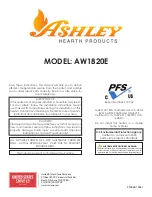
-13-
8. Burn small, intense fires instead of large, slow burning fires when possible. Large slow burning fires can deposit
creosote within the heating system.
9. Learn your appliance’s operating characteristics to obtain optimum performance.
VISIBLE SMOKE
The amount of visible smoke being produced can be an effective method of determining how efficiently the
combustion process is taking place at the given settings. Visible smoke consist of unburned fuel and moisture
leaving your stove. Learn to adjust the air settings of your specific unit to produce the smallest amount of visible
smoke. Wood that has not been seasoned properly and has a high wood moisture content will produce excess
visible smoke and burn poorly.
AIR TUBES
The air tubes assembled in this unit are designed to provide an accurate mix of secondary air to ensure the
highest efficiency. Any damage or deterioration of these tubes may reduce the efficiency of combustion. The
air tubes are held in position by either screws or snap pins. Locate these to either side of the tube and remove to
allow the tube to be removed and replaced.
BLOWER OPERATION
The variable speed blower circulates air warmed by the firebox into the living area to distribute the heat more
evenly. The blower control knob is located on the side of the blower housing. Turn the knob clockwise to turn the
blower on. The speed is controlled by turning the knob clockwise for slower speeds and counter-clockwise for
faster speeds. To turn the blower off, turn the speed control knob fully counter-clockwise. It is recommended to
turn the blower off when the unit is not in operation. The blower needs to be removed and air-blown clean. Make
sure the blades do not have build up.
CAUTION:
Do not overfire appliance. You are overfiring if any part of the appliance glows red. Close the door and shut
damper immediately to reduce the air supply and slow down the fire.
Chimney Maintenance
CAUTION:
Slow burning fires for extended use or burning green wood may cause excessive creosote build-up. Ignition of
creosote or overfiring could cause a chimney fire. Chimney fires burn extremely hot and may ignite surrounding
combustible materials. In case of a chimney fire, call the fire department immediately!
CREOSOTE - FORMATION AND REMOVAL
When wood is burned slowly, it produces tar and other organic vapors which combine with expelled moisture
to form creosote. The creosote vapors condense in the relatively cool chimney flue of a slow-burning fire and
can accumulate on the flue lining. If ignited, this creates an extremely hot fire in the chimney which may ignite
surrounding materials resulting in a building fire. The chimney connector and chimney should be inspected (at
least) twice a month during the heating season to determine if a creosote buildup has occurred. If it has, it should
be removed. Failure to remove creosote may result in ignition and may cause a house/building fire. Creosote
may be removed using a chimney brush or other commonly available materials from your local hardware retailer.
Chimney fires burn very hot. If the unit or chimney connector should glow red, reduce the fire by closing the inlet
air control and immediately call the fire department. A fire in the firebox may be smothered by pouring a large
quantity of coarse salt, baking soda, or cool ashes on top of the fire.
PREVENTING CREOSOTE BUILD-UP
1. Burn the unit with the air control wide open (in the “Hi” position) for 15 to 20 minutes at numerous intervals
throughout the day during the heating season, being careful not to overfire the unit.
2. Establish a routine for the handling of fuel, wood burner and firing technique. Check daily for creosote buildup
until experience shows how often you need to clean for safe operation. Be aware that the hotter the fire,
the less creosote is deposited, and weekly cleaning may be necessary in mild weather even though monthly
cleaning may be enough in colder months.
CAUTION:
A chimney fire may cause ignition of wall studs or rafters which were assumed to be a safe distance away from
the chimney. If a chimney fire occurs, have your chimney inspected by a qualified expert before using again.
Содержание Ashley AW1820E
Страница 19: ... 19 Notes ...














































